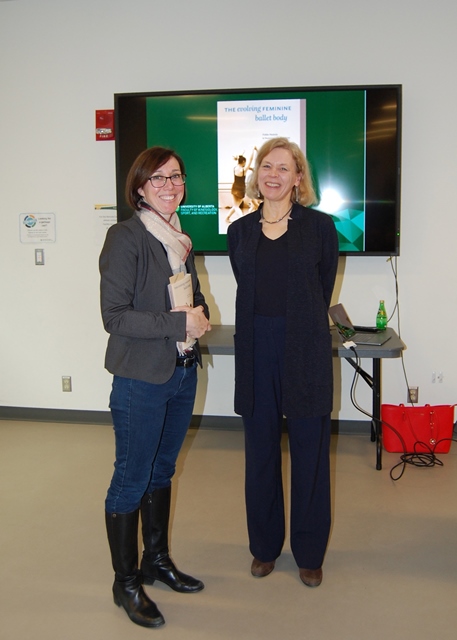
Pirkko Markula (right) and chapter author Kate Davies at the book launch event for The Evolving Feminine Ballet Body. Photo: University of Alberta Press
Both celebrated and critiqued through the ages for its thin, flexible and highly feminized aesthetic, the ballet body has become increasingly visible within contemporary culture thanks to the popularity of a host of reality shows such as So You Think You Can Dance and its entrance into the fitness industry through barre classes and the like.
A new book edited by Pirkko Markula, professor in the Faculty of Kinesiology, Sport, and Recreation, and Marianne Clark, faculty alumna, explores the ballet body in contemporary society and how it has shaped, and is shaped by, culture over time.
The researchers of book, titled The Evolving Feminine Ballet Body, all former and current students of the Faculty of Kinesiology, Sport, and Recreation, examine the increasing intersections between ballet and popular culture, the fitness industry, and recreational ballet participation. Once considered solely a high art form, this book focuses on diverse representations and experiences of ballet beyond that of the professional ballerina.
"The ballet body was an energetic body capable of expressive movement and also a disciplined body linked to dominant notions of ideal femininity and neoliberal citizenship. But its meanings shifted with changing context," said Markula. "For example, the popular children's literature, the fitness workouts, and the popular reality shows continued to reinforce the ideal feminine ballet body. Yet, the recreational ballet dancers were able to make multiple meanings in their dance contexts. But, as the history of ballet demonstrates, the ballet body keeps evolving through multiple settings."
Markula says the book, which sees each chapter written a different researchers, was envisioned to emphasize how the ballet body is currently represented in different popular media sources and through women's lived experiences of ballet, whether that be in a beginner's adult ballet class or a studio class with serious and skilled young dancers.
"The book considers the historical context of ballet and outlines how the feminine ballet body changed from professional dancers at medieval courts to the sexualized body in the 1800s Paris to the celebrated, ethereal star ballerina."
Against this background, Markula continues, the authors explored "lived experiences of ballet in several recreational contexts, particularly in Alberta, that all provide different ways to understand the ballet body."
"Throughout this book, the ballet body danced in diverse contemporary locations: in children's books, in popular reality television shows, in online workouts, and in studios to reveal the many faces of ballet in Alberta: the young dancers who found solace in the local studios; the university students attending their ballet classes; the Albertan ballerinas performing in SYTYCD; and us, the authors, who all conducted our studies in Alberta."
In one chapter, authors Lindsay Eales and Kelsie Acton, two current PhD students in the faculty, look at teaching ballet in integrated dance contexts, which brings together people with and without disability to dance together.
"Our chapter is intended to provide a perspective on our integrated dance teaching practice including some of our major concerns-like the tendency for dance for people with disabilities to be considered therapy-how it has evolved, and how we continue to practice reflexivity around our teaching practice," says Acton.
Using their experience of integrated dance teaching, Acton and Eales work through several processes, including a review of previous literature, examination of the pleasures and dangers inherent in disciplined ballet practice, and a conversational format to establish a safe, inclusive ballet technique.
"Instead of the strict control of traditional ballet movement that assumes normalization and idealized bodies, our inclusive ballet technique-which can be used in all integrated dance contexts-opens up the range of possible movements for integrated dancers and provides them with the tools to make choices about how they will move in relationship to traditional ballet movements."
Overall, the authors of The Evolving Feminine Ballet Body demonstrate that the dancers and their teachers were passionate about ballet, but also used it as a tool to challenge the idealized feminine body, social stereotypes of disability, or dominant ideas of what constitutes a dancing body.
The book can be found at Audrey's Books or online through University of Alberta Press